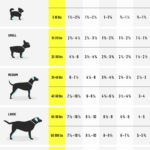Why Does My Dog Not Want To Walk
When Your Furry Friend Refuses to Walk: Understanding the Reasons and Solutions
Dogs are known for their love of walking and exploring the world around them. However, sometimes they may not want to walk, which can be frustrating or concerning for their owners. If you have ever experienced this situation, you might wonder why your dog is behaving like this and what you can do about it. In this article, we will explore some possible reasons why your dog does not want to walk and offer some tips on how to encourage them to move.
Possible Subtitles:
1. The Importance of Walking for Dogs
2. Common Causes of Walking Refusal in Dogs
3. How to Diagnose and Treat Physical Issues
4. How to Address Behavioral Issues
5. Ways to Make Walking Fun and Safe for Your Dog
The Importance of Walking for Dogs
Walking is not only a physical activity but also a mental one for dogs. It allows them to stretch their legs, burn off energy, and stimulate their senses by smelling, hearing, seeing, and feeling different things along the way. Moreover, walking can strengthen the bond between you and your dog as you share an experience together. Regular walking can also prevent obesity, improve cardiovascular health, enhance immune function, reduce stress and anxiety, and promote better sleep for dogs.
Common Causes of Walking Refusal in Dogs
There are various reasons why dogs may refuse to walk or resist going outside. Some possible causes include:
Physical issues:
– Pain or discomfort from injury, illness, arthritis, hip dysplasia, or other conditions that affect mobility or balance.
– Heat exhaustion or dehydration in hot weather.
– Cold intolerance or frostbite in cold weather.
– Overgrown nails or paw pads that are sore or injured.
– Digestive problems such as constipation or diarrhea that make dogs feel uncomfortable.
Behavioral issues:
– Fear or anxiety of unfamiliar places, people, animals, noises, or objects.
– Separation anxiety when the owner leaves the house or goes in a different direction.
– Boredom or lack of stimulation from routine routes or activities.
– Dominance or aggression toward other dogs or humans that provoke conflicts.
– Distraction by food, toys, scents, or sounds that make dogs lose focus on walking.
How to Diagnose and Treat Physical Issues
If you suspect that your dog’s reluctance to walk is due to physical problems, you should consult a veterinarian for a thorough examination. The vet may perform some tests such as X-rays, blood work, urinalysis, or fecal analysis to detect any underlying conditions. Based on the diagnosis, your dog may need medication, surgery, therapy, or special care to manage their symptoms and improve their mobility. For example:
– Pain relief medication such as NSAIDs (nonsteroidal anti-inflammatory drugs) may help alleviate joint pain and inflammation caused by arthritis or injury.
– Supplements such as glucosamine/chondroitin or fish oil may support joint health and reduce stiffness in dogs with osteoarthritis.
– Physical therapy such as massage, hydrotherapy, acupuncture, or chiropractic may help restore muscle strength and range of motion and relieve pain in dogs with orthopedic issues.
– Rehabilitation devices such as braces, carts, or slings may assist dogs with impaired mobility due to paralysis or amputation.
– Lifestyle changes such as weight management, diet modification, exercise regime adjustment may prevent further damage to joints and organs and promote overall health in dogs with chronic conditions.
How to Address Behavioral Issues
If your dog’s aversion to walking is rooted in behavioral factors, you can try some techniques to overcome them gradually. Here are some possible solutions:
Fear or anxiety:
– Gradual desensitization: expose your dog to the trigger (e.g., loud noise) at a low intensity and reward them for calm behavior, then gradually increase the intensity until they can tolerate it.
– Counterconditioning: associate the trigger with a positive experience (e.g., treats, playtime) to change your dog’s emotional response from fear to joy.
– Medication: in severe cases, your vet may prescribe anti-anxiety medication or pheromone therapy to help your dog feel more relaxed.
Separation anxiety:
– Practice short departures and return gradually: start with leaving for a few seconds and coming back, then increase the time duration as your dog gets used to it.
– Create a safe space for your dog: provide a comfortable crate, bed, toys, and familiar scents that make your dog feel secure and relaxed when you are not around.
– Use audio or visual cues that signal your absence: play calming music or leave the TV on, or leave a piece of clothing with your scent on it.
Boredom:
– Change the walking route or environment: explore new places, take different paths, vary the pace or direction of walking to stimulate your dog’s curiosity and interest.
– Use interactive toys or games during walks: bring a ball, frisbee, tug toy, or puzzle feeder that requires your dog’s engagement and rewards their effort.
– Increase the frequency or duration of walks: if possible, give your dog more opportunities to walk and explore different areas.
Dominance or aggression:
– Train your dog consistently: use positive reinforcement methods such as treats, praise, and clickers to teach basic commands (e.g., sit, stay, come), leash manners (e.g., loose leash walking), and socialization skills (e.g., greeting other dogs calmly).
– Avoid confrontational situations: steer clear of dogs or people that trigger aggressive behavior in your dog by crossing the street or changing directions.
– Seek professional help if necessary: consult a certified dog trainer or behaviorist who can assess your dog’s behavior and offer customized training plans.
Distraction:
– Teach your dog to focus on you: use attention cues (e.g., name, whistle) to get your dog’s attention and reward them for looking at you.
– Use high-value treats or toys as rewards: bring something that your dog loves and only gets during walks as a motivator.
– Practice impulse control exercises: teach your dog to wait, sit, or lie down before getting a treat or toy to improve their self-control.
Ways to Make Walking Fun and Safe for Your Dog
Apart from addressing the underlying causes of walking refusal in dogs, you can also make walking more enjoyable and safe for your furry friend by following these tips:
– Dress appropriately for the weather: use a coat, boots, or sunscreen depending on the temperature and sun exposure.
– Bring water and snacks: keep your dog hydrated and energized during long walks by carrying a water bottle and some treats.
– Use a comfortable harness or collar: choose a well-fitted harness or collar that does not choke or restrict your dog’s breathing or movement.
– Use a sturdy leash: use a leash that is strong enough to handle your dog’s weight and force, but not too heavy or short that it limits their freedom.
– Watch out for signs of fatigue, stress, or pain: monitor your dog’s body language and behavior for any signs of discomfort such as limping, panting heavily, cowering, growling, or hiding. If you notice any of these signs, stop walking immediately and seek help if necessary.
– Have fun with your dog: play games with your dog such as fetch, hide-and-seek, or tag during walks to engage their senses and promote bonding between you two.
Conclusion
Walking is an essential part of a dog’s life that provides physical exercise, mental stimulation, social interaction, and emotional satisfaction. However, sometimes dogs may refuse to walk due to physical or behavioral issues that require diagnosis and treatment. By understanding the underlying causes and using appropriate techniques, you can help your dog overcome their reluctance to walk and enjoy the benefits of exploring the world together. Remember to make walking fun and safe for your dog by dressing appropriately, bringing water and snacks, using comfortable gear, watching out for signs of distress, and having fun with your furry friend.



